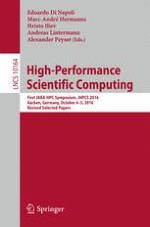2017 | Book
High-Performance Scientific Computing
First JARA-HPC Symposium, JHPCS 2016, Aachen, Germany, October 4–5, 2016, Revised Selected Papers
Editors: Edoardo Di Napoli, Marc-André Hermanns, Hristo Iliev, Andreas Lintermann, Alexander Peyser
Publisher: Springer International Publishing
Book Series : Lecture Notes in Computer Science
